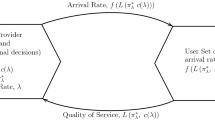Abstract
In an M/M/1/C queue, customers are lost when they arrive to find C customers already present. Assuming that each arriving customer brings a certain amount of revenue, we are interested in calculating the value of an extra waiting place in terms of the expected amount of extra revenue that the queue will earn over a finite time horizon [0, t]. There are different ways of approaching this problem. One involves the derivation of Markov renewal equations, conditioning on the first instance at which the state of the queue changes; a second involves an elegant coupling argument; and a third involves expressing the value of capacity in terms of the entries of a transient analogue of the deviation matrix. In this paper, we shall compare and contrast these approaches and, in particular, use the coupling analysis to explain why the selling price of an extra unit of capacity remains the same when the arrival and service rates are interchanged when the queue starts at full capacity.





Similar content being viewed by others
Notes
Note that the origin of the terminology “Poisson’s equation” comes from the theory of partial differential equations, and was chosen due to certain similarities in the structure of the equations.
References
Abate, J., Whitt, W.: Numerical inversion of Laplace transforms of probability distributions. ORSA J. Comput. 7(1), 36–43 (1995)
Asmussen, S., Albrecher, H.: Ruin Probabilities, vol. 14. World Scientific, Singapore (2010)
Carbonell, F., Jimenez, J.C., Pedroso, L.M.: Computing multiple integrals involving matrix exponentials. J. Comput. Appl. Math. 213(1), 300–305 (2008)
Chao, X.: On the departure processes of \(M/M/1/N\) and \(GI/G/1/N\) queues. Adv. Appl. Probab. 24(1), 751–754 (1992)
Chiera, B.A., Taylor, P.G.: What is a unit of capacity worth? Probab. Eng. Inf. Sci. 16(04), 513–522 (2002)
Coolen-Schrijner, P., van Doorn, E.A.: The deviation matrix of a continuous-time Markov chain. Probab. Eng. Inf. Sci. 16(3), 351–366 (2002)
Hautphenne, S., Kerner, Y., Nazarathy, Y., Taylor, P.: The intercept term of the asymptotic variance curve for some queueing output processes. Eur. J. Oper. Res. 242(2), 455–464 (2015)
Huang, Y., McColl, W.: Analytical inversion of general tridiagonal matrices. J. Phys. A Math. Gen. 30(22), 7919 (1997)
Koole, G.M., Spieksma, F.M.: On deviation matrices for birth–death processes. Probab. Eng. Inf. Sci. 15(02), 239–258 (2001)
Mufa, C.: Optimal Markovian couplings and applications. Acta Math. Sin. 10(3), 260–275 (1994)
Acknowledgments
The authors would like to acknowledge the support of the Australian Research Council (ARC) through Laureate Fellowship FL130100039 and the ARC Centre of Excellence for the Mathematical and Statistical Frontiers (ACEMS). Sophie Hautphenne would further like to thank the ARC for support through Discovery Early Career Researcher Award DE150101044.
Author information
Authors and Affiliations
Corresponding author
Rights and permissions
About this article
Cite this article
Braunsteins, P., Hautphenne, S. & Taylor, P.G. The roles of coupling and the deviation matrix in determining the value of capacity in M/M/1/C queues. Queueing Syst 83, 157–179 (2016). https://doi.org/10.1007/s11134-016-9480-3
Received:
Revised:
Published:
Issue Date:
DOI: https://doi.org/10.1007/s11134-016-9480-3




